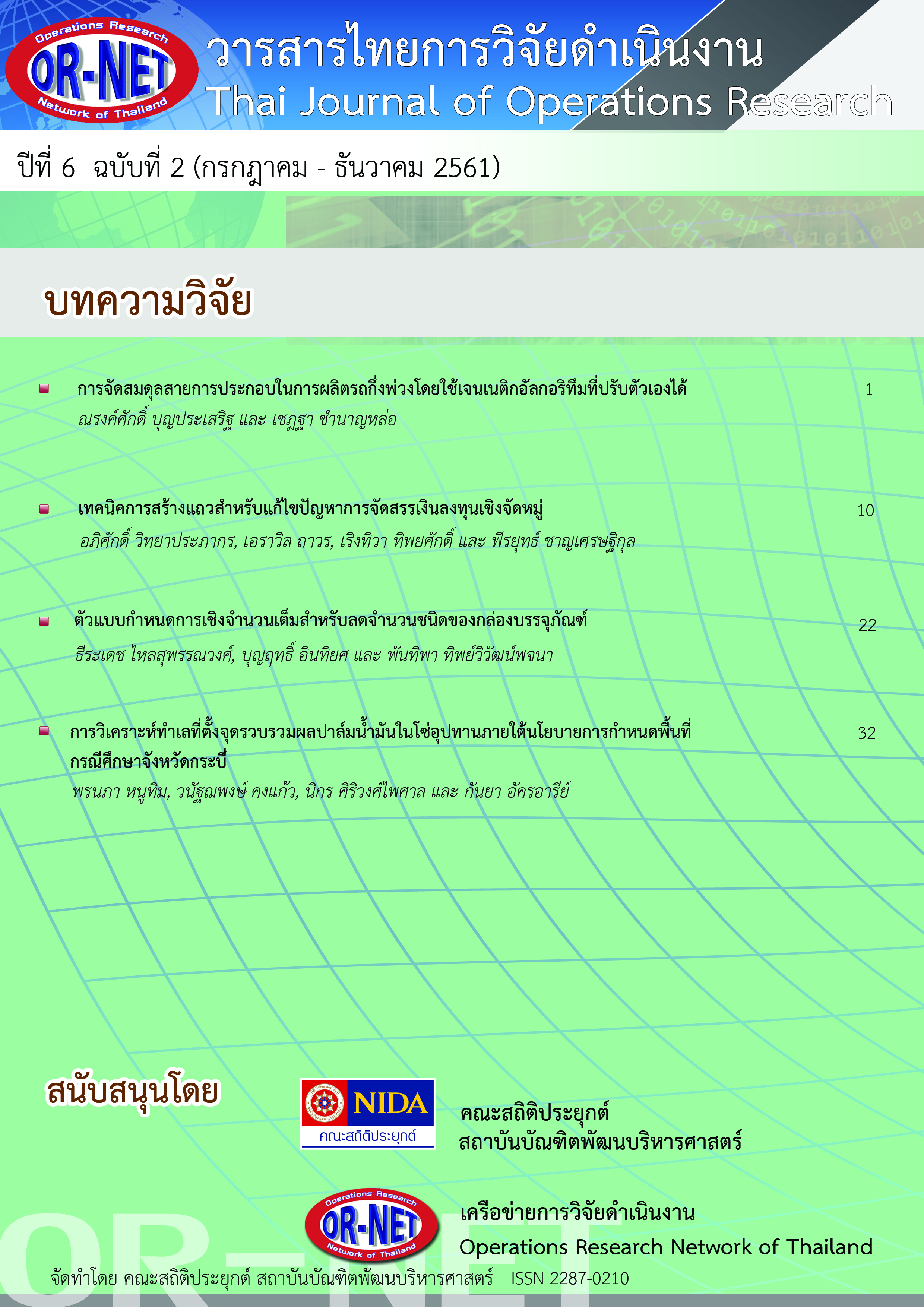Assembly Line Balancing in Semi-trailer Production using Adaptive Genetic Algorithm
Keywords:
Assembly line balancing, Semi-trailer production, Genetic algorithm, Auto-tuning parametersAbstract
In semi-trailer production, the mixed assembly line balancing is one of important work to increase productivity. Flat bed & low bed semi-trailer and container chassis semi-trailer are two products in the same family which is assembled in the same line. Then, the assembly line is mixed models implemented for utilizing resources. At the number of workstations is fixed, the averaged cycle time is the objective function of the problem solving, so it could response the several demands today. However, this research problem is well-known as NP-hard, and it is very hard to solve by mathematical models. Thus, the meta-heuristic such as Genetic algorithm (GA) is introduced to balance the mixed-models line of the case study. Moreover, Adaptive genetic algorithms including GA with Rough auto-tuning parameters (GA-RA) and GA with Fine auto-tuning parameters (GA-FA) are developed to apply the same problem and compare with the simple GA. In summarized, the GAs could be used to balance the mixed-models line, and GA-FA is the best effectiveness.
References
[2] N. Kriengkorakot and N. Pianthong, “The assembly line balancing problem: Review articles,” KKU Engineering Journal, Vol. 34, No. 2, pp.133-140, 2007.
[3] C., Chamnanlor, K., Sethanan, C.F., Chien and M., Gen, “Re-entrant flow shop scheduling problem with time windows using hybrid genetic algorithm based on auto-tuning strategy,” International Journal of Production Research, Vol. 52, No.9, pp.2612-2629, 2014.
[4] A., Sofia Simaria and M., Vilarinho, “A genetic algorithm based approach to the mixed-model assembly line balancing problem of type II,” Computers & Industrial Engineering, Vol. 47, No.4, 391-407, 2004.
[5] U., Mohammad Kamal, L., Jose Luis Martinez, “Assembly Line Balancing and Sequencing”, Assembly Line–Theory and Practice, Prof. Waldemar Grzechca (Ed.), ISBN: 978-953-307-995-0, In Tech, 2011.
[6] เชฎฐา ชำนาญหล่อ, จักรินทร์ กลั่นเงิน, และไตรภพ แซ่ตั้ง. “การประยุกต์ใช้เทคนิคการหาค่าที่เหมาะสมที่สุดในการจัดสมดุลสายการผลิตอุปกรณ์อิเล็กทรอนิกส์,” วารสารวิทยาศาสตร์ มข. ปีที่ 44(ฉบับที่ 4), หน้า 809-819, 2559.
[7] R. Pitakaso and K. Sethanan. “Modified differential evolution algorithm for simple assembly line balancing with a limit on the number of machine types,” Engineering Optimization, Vol. 48, No.2, pp.253-271, 2016.
[8] A. Noorul Haq, J. Jayaprakash and K. Rengarajan. “A hybrid genetic algorithm approach to mixed-model assembly line balancing,” International Journal of Advanced Manufacturing Technology, Vol. 28, pp.337-341, 2006.
[9] W. Zhang and M. Gen, “An efficient multiobjective genetic algorithm for mixed-model assembly line balancing problem considering demand ratio-based cycle time,” Journal of Intelligent Manufacturing, Vol. 22, pp.367-378, 2011.
[10] P., Su and Y., Lu, “Combining Genetic Algorithm and Simulation for the Mixed-model Assembly Line Balancing Problem,” Third International Conference on Natural Computation (ICNC 2007), pp.314-318, 2007.
[11] P., Sivasankaran and P., Shahabudeen, “Genetic Algorithm for con-current balancing of mixed-model assembly lines with original task times of models,” Intelligent Information Management, Vol.5, pp.84-92, 2013.
[12] A.A., Mamun, A.A., Khaled, S.M., Ali and M.M., Chowdhury, “A heuristic approach for balancing mixed-model assembly line of type I using genetic algorithm,” International Journal of Production Research, Vol.50, pp.5106-5116, 2012.
[13] A., Noorul Haq, J., Jayaprakash and K., Rengarajan, “A Hybrid genetic algorithm approach to mixed-model assembly line balancing,” The International Journal of Advanced Manufacturing Technology, Vol. 28, pp.337-341, 2006.
[14] Z., Zhang and M., Gen, “An efficient multi objective genetic algorithm for mixed-model assembly line balancing problem considering demand ratio-based cycle time,” Journal of Intelligent Manufacturing, Vol. 22, pp.367-378, 2011.
[15] Y.S., Yun and M. Gen, “Performance analysis of adaptive genetic algorithms with fuzzy logic and heuristics,” Optimization Decision Making, Vol. 2, No.2, pp.161-175, 2003.




